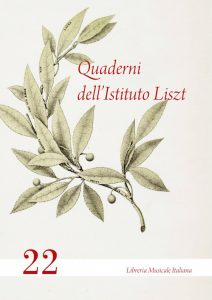SAGGI
Eleonora Pipia
« L’homme de génie, c’est la nature entière qui devient parole ». Literary Romanticism in the Parisian experience of Franz Liszt
Bozhidar Chapkanov
Liszt’s late explorations of non-tonal harmonic relationships: A neo-Riemannian analysis of Bagatelle sans tonalité
Antonio Grande
Liszt, Sonetto 47 del Petrarca. A narratological approach
 COMUNICAZIONI
COMUNICAZIONI
Michele Calella
LisztQWV: un catalogo digitale delle fonti e delle opere lisztiane
RECENSIONI
Willy Bettoni, Franz Liszt under the light of progress. The idea of Mehrdeutigkeit as aesthetic paradigm in the piano compositions between the B minor Sonata and the Bagatelle sans tonalité, Baden-Baden, Rombach Wissenschaft, 2021 (Rossana Dalmonte)
Robert Doran (ed.) Liszt and virtuosity, Rochester, University of Rochester Press, 2020 (Mariateresa Storino)
ABSTRACTS
Eleonora Pipia
« L’homme de génie, c’est la nature entière qui devient parole ». Literary Romanticism in the Parisian experience of Franz Liszt
Franz Liszt arrived in Paris during the intense years of European Romanticism, when he was only sixteen. What influence did this contact have on the construction of his identity? The connection with this cultural milieu leaves a trace on his theoretical production: for one thing, we find a deep social reflection already posed by Alfred de Vigny, that Liszt very precisely takes up in the Lettres d’un bachelier ès-musique. But Franz Liszt is also associated by his contemporaries with the enthusiasm of German Romanticism: he has been compared, for example, to E.T.A. Hoffmann, becoming a caricature and double, and points of contact with the life of the main character of Kreisleriana have often been found. Liszt thus becomes both a mediator and central figure of the Romantic movement.
Bozhidar Chapkanov
Liszt’s late explorations of non-tonal harmonic relationships: A neo-Riemannian analysis of Bagatelle sans tonalité
This article offers a detailed harmonic analysis of one of Liszt’s last completed compositions — Bagatelle sans tonalité — and positions the piece in the context of the composer’s life-long involvement with music theory. The influence of François-Joseph Fétis’ and Karl Friedrich Weitzmann’s theoretical writings are summarised in the context of Liszt’s strive towards abandoning all tonal implications and resolutions in a harmonically adventurous piece such as the Bagatelle. Neo-Riemannian theory and more specifically Tonnetz visualisations are employed throughout the analysis, in order to focus in detail on the chord-to-chord relations under chromatic voice leading, setting aside the potential functional implications of chords.
Antonio Grande
Liszt, Sonetto 47 del Petrarca. A narratological approach
This proposal intends to provide new contributions to the Sonetto 47 del Petrarca, a piano piece (albeit parallel to a version for voice and piano) that Liszt published together with the poetic text, as if to emphasize its close expressive link. The narratological approach seems to have the most suitable requirements to intercept the semantic complexity running through a piece like this. Indeed, it offers a plurality of perspectives, starting with the concept of focalization and the mimetic/diegetic dichotomy. It also regards a piece as a place where different and independent temporal shifts coexist, forwards as well as backwards. In the present case, the question becomes critical due to Liszt’s choice to work on a 14th century sonnet because of its distance from the 19th century musical idiom.
In the Introduction (bb. 1–10), where the composer’s voice emerges on a mimetic level, two different expressive registers are highlighted: a) the outpouring of feelings in the passionate and multifaceted gesture of a major 3rd-cycle (bb. 1–4), and b) a recitative style conveying the thoughtful and mournful side of falling in love, also intended as prolepsis with respect to a subsequent re-proposal, on the mimetic side, by the narrator-singer. In addition, there is a recurring main melody, elegiac in colour, which — thanks to an off-beat piano writing and an evocative simplicity of structure — suggests ecstatic purity and religious contemplation. The proposal also argues the difference between the discourse vs fabula level, on a temporal scale, to be found when, in correspondence with the shortest stanzas of the Sonetto, the music expands at greater length.